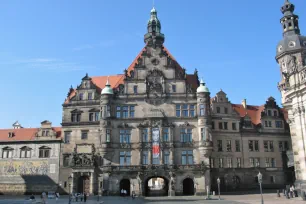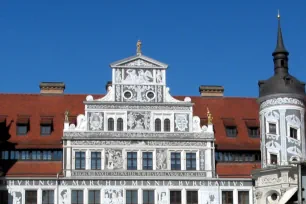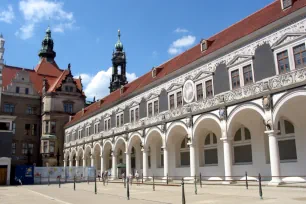For centuries, the Residenzschloss – the royal palace in Dresden – served as the seat of government for the Saxon Rulers of the Wettin family. Today it is home to a number of museums, including one of Dresden’s most famous attractions, the Green Vault, a large treasure chamber.

The vast palace is located in the heart of historic Dresden and comprises a number of wings and structures that were built over a span of several centuries.
History
The origin of the Residenzschloss goes back to the thirteenth century when a fort was built here. The fort was first expanded in the early fifteenth century, when the Hausmann Tower was built. In 1530 George the Bearded, duke of Saxony, commissioned the construction of the Georgenbau as the residence of the Wettin Family. During the reign of Maurice, elector of Saxony in the mid-sixteenth century, the castle further evolved into a magnificent Renaissance palace, and it continued to expand during the latter half of the sixteenth century when the Royal Stables and the Langer Gang were built.

In 1701 a fire destroyed a large part of the Residenzschloss, in particular the Georgenbau which was soon rebuilt in Baroque style by Augustus the Strong, at the time elector of Saxony. The palace was last expanded between 1889 and 1901 marking the 800th anniversary of the Wettin Dynasty.
Like all landmarks in Dresden, the Royal Palace was destroyed in 1945. For more than forty years, the building stood in ruins, with only the Georgenbau rebuilt between 1962 and 1969. Reconstruction of the whole Residenzschloss started in 1985 with the intention to recreate it as a cultural and museum complex. It was mostly completed in 2006, just in time for the city’s 800-year anniversary. However, construction on the castle is expected to continue until 2013.
The Palace

The Schlossplatz (castle square) at the end of the Augustusbridge leads to the Georgentor, the monumental entrance gate to the Georgenbau, the central section of the palace. Today the Georgenbau is home to the art library and the library of the coin collection. The Georgentor was built in 1902 at the site of an earlier gate. It is named after George the Bearded, whose equestrian statue decorates the center of the front façade.
To the right of the Georgentor is the heart of the palace, centered around a large inner courtyard, known as the Great Court. It is surrounded by magnificent Renaissance façades decorated with sgraffito. At the center of the north wing stands the Haussman Tower, a 1991 reconstruction of the early fifteenth-century tower. A platform at the top of the tower gives visitors a great view over Dresden’s inner city. A covered bridge near the tower connects the Residenzschloss with the Hofkirche.

On the other side of the Georgentor one finds a large courtyard which was used to hold jousting tournaments. To the north of the courtyard is the Langer Gang (long corridor), a long beautiful arcade that leads to the Johanneum, the former royal stables.
The north side of the Langer Gang, facing Augustusstrasse, is decorated with a more than one-hundred-meter-long ceramic mural. Known as the Furzenzug or procession of Princes, it shows important figures in the history of Saxony.
Museums
The Royal Palace is home to a number of interesting museums. The most famous is the Grünes Gewölbe (Green Vault) – one of Europe’s most magnificent treasure chambers with some 3,000 treasures.
The Münzkabinet (Coin Cabinet) exhibits a collection of coins in the Hausmann Tower. Another museum in the royal palace is the Kupferstich-Kabinett, which has a collection of prints drawings and photographs.
And make sure you don’t miss one of the palace’s most recent attractions: the Türckische Cammer (Turkish Room), a museum with oriental weaponry and related artifacts. One highlight is a magnificent twenty meters long Ottoman tent, made of gold and silk.
- Next: Kreuzkirche
- More Sights & Attractions in Dresden

